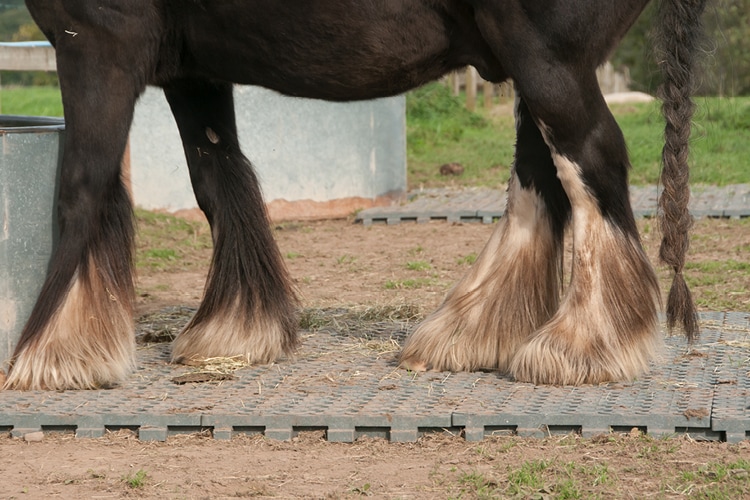
Mud fever occurs in horses all over the world. This skin inflammation affects mostly cold-blooded horses and horse breeds with a lot of hair. Mud fever occurs most frequently during seasons when the coat changes, i.e. in autumn and spring.
The prevalence (frequency) increases with age and especially in white-furred horses.
However, horse breeds without much coat can also be affected. Apart from old horses, pregnant mares and young horses are particularly susceptible. However, the disease is not contagious.
The first symptoms of the disease are warm, reddened and swollen areas in the bend of the fetlock. In the following stage, the skin tears. The ooze then usually forms a greasy film that becomes a breeding ground for bacteria and fungi after a scab has formed on it. If the mud fever is already chronic, the skin thickens due to systematic skin growths.

The outbreak of mud fever is usually due to one of the following two reasons:
These causes clearly show that, in most cases, mud fever is triggered internally, which in turn can have an effect on the quality and structure of the skin.
Micro-injuries and a poor structure of the horse's skin are frequent triggers for mud fever. If the horse then stands on too wet a surface as a result of inadequate stable hygiene, mud fever can break out.
Since in most cases, the first cause of the disease is the above-mentioned causes, the first thing to do is to check the horse's overall condition.
A detoxification disorder can be the reason for an increased need of trace elements and a zinc deficiency.
It is particularly important that the horse's feed is checked in cases of mud fever. If the liver and kidneys cannot fulfil their function one hundred percent or if the horse is struggling with intestinal problems, the body uses the skin as an alternative detoxification organ. Therefore, roughage quality should be checked first. Since roughage stresses liver metabolism, it should be avoided in the future.
The horse's protein intake should also be limited, as excessive amounts of protein (on a paddock day) overload the liver and kidneys. Overfeeding of protein can lead to a trace element deficiency, which leads to dangerous skin changes that make the skin susceptible to parasites and fungi.
To reduce protein intake, very high quality hay must replace grass and hay silage. Concentrated feed should be limited to the bare minimum and artificial additives in supplementary feeds should be avoided. In addition to zinc, the detoxifying organs can be supported by the administration of special detoxifying herbs.
Zinc is the key to good hooves, great skin, shiny coat and an all-round healthy metabolism and immune system. The need for this trace element for new hair formation is especially high during the change of coat. Horses that do not have a high energy requirement often have a micronutrient deficiency due to the constantly regulated feeding. In horse breeds with a lot of pastern hair, this can lead to an outbreak of mud fever.
When adding zinc, it is also important to ensure that it is of particularly high quality (organic). In a few cases, a primary manganese deficiency can also be the trigger for mud fever.
Apart from clarifying possible deficiencies and disorders of the horse's system, as well as their treatment, wound care should not be neglected.
The areas affected by mud fever should be shorn so that they can be treated in a targeted manner. When the coat is gone, more fresh air can reach the wounds, allowing them to heal more quickly.
As bacteria and fungi are more likely to form and spread under the scabby crusts of the sore, these should be removed with care. The wound can then be treated with a mild soap and suitable creams.
To care for the affected areas, Muddoc Maukesalbe can help. It fights bacteria and therefore also prevents future outbreaks. To keep the freshly cleaned wounds clean, special mud boots and Keratex Mud Shield Powder can help keep the affected areas clean and dry.
Best home remedies for mud fever